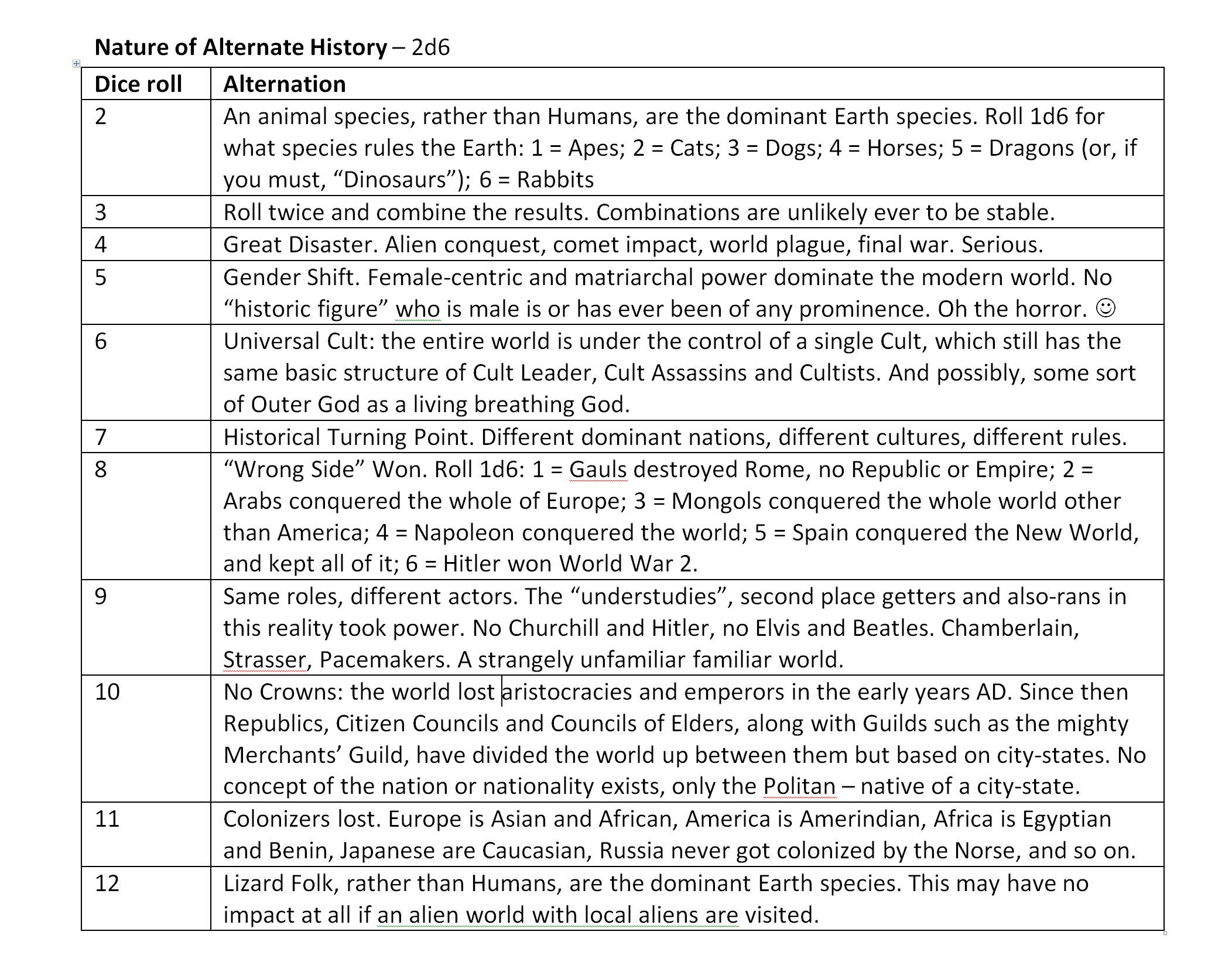
TIME TRAVEL
Time Travel is one possible form of Time Control (FASERIP RPG page 81). The FASERIP RPG version of Time Travel power allows travel into the past or future a number of decades equal to the Power’s Rank value. Clearly, this is not even remotely how Time Travel works in comic books, movies, streaming shows or general science fiction.
The rules provided here replace the FASERIP RPG rules for Time Travel in all cases if used.
First Law of Time: THE PRESERVATION OF THE ENERGY OF INFORMATION
The difficulty of changing an event in a specific time period varies with the square of the amount of information relating to that event.
Every measurable moment of time is a product of an infinite number of previous and future moments. Completely isolating an “event” in time such as the signing of a treaty, the declaration of a war, a love affair, a death- is an impossibility. Knowing two pieces of information about a given event make it four times harder to effect any change to the event. In ignorance lies the power to change the details. As soon as someone becomes anonymous or forgotten by history for any length of time, any number of extra events or “missing adventures” can be added to the sum total of their life.
Second Law of Time: THE PRINCIPLE OF ORTHOGONAL HISTORICITY
The tendency of any Timestream is to follow its most likely thermodynamic and chronodynamic track, and its applicable law of physics and sociology will dictate the degree of change possible by someone entering the reference frame from another time period.
Leading on from the First Law, because any event is part of an interwoven tapestry of surrounding events, it is difficult to stop the inertia of history from overwhelming attempted changes in such a way that the effect of any change is always minimised. Killing Hitler doesn’t stop Nazi Germany; it ultimately may mean no more than a different man is remembered as the Supreme Leader, as an example.
Third Law of Time: THE LIMITATION PRINCIPLE
The number of basic changes to any event is limited by the relative certainty of the event. The chance of successfully changing an event varies with the inverse square of the number of time travelling attempts to alter it.
Isolating an event is the relatively easy part. For example stopping a particular research project might come down to stopping a researcher from getting on a specific flight to Germany. However, the mere act of examining the event causes the event to become better known. This means that the operation of Time Laws One and Two makes each attempt to change history after the first progressively much harder. If characters time travel to change an event, stop someone doing something and so on, and fail, if they return to try again there is a cumulative penalty for each subsequent attempt. First attempt: no penalty. Second attempt: -3RS on all rolls made while in the other time period. All rolls. Third attempt: -6RS penalty. Fourth attempt: -12RS. Fifth and subsequent attempt: -24RS.
Fourth Law of Time: THE DIRECTIONLESS MOMENT
Time’s smallest measurable passage has no objective direction. For any moment, there is at least one supporting moment, but this relationship does not imply a direction in the flow of the Timestream.
The Fourth Law says that time is perhaps less like a river and more like an avalanche of wreckage composed entirely of pigeonhole shelving. Any particular “Timestream” or timeline created by mortal perception of the passage of time is in reality composed of a random sampling of moments from a range of different ‘universes’ (frequencies) strung together my mortal subconsciousness into an apparently coherent whole.
The degree to which supposed history as taught and remembered is founded, not on personal experience or “fact” but on acceptance of other people’s stories is truly remarkable.
It is always exactly as difficult to travel from a destination as to travel to it. Same basic difficulty of roll required.
Time Storms surround some locations in space and time. This means that so many time travellers have already visited the location, and so much Karma has been fruitlessly spent there, that it is permanently harder to arrive anywhere close in time to that destination. Such Time Storms inflict a further -3RS penalty on any Time Control Time Travel roll to arrive there.
Time Shoals are areas in space time much easier to reach repeatedly than other locations across the timeline. Time Shoals have no modifier to the basic Power roll on Time Control Time Travel to travel to. Each time a Time Shoal is visited after the tenth visit, there is a cumulative 10% chance each visit that the Time Shoal will turn into a Time Storm before the next Time Travel roll is attempted. There will be no sign of this until the Time Travel attempt is made.
It is absolutely possible for a time traveller to use Devices either of their own invention or otherwise to navigate to and from the desired time period with much greater accuracy and control. If the time traveller uses a vehicle to travel then a navigation device can be bought, stolen or invented to confer a bonus on the Time Travel roll.
The absolute “range” in years that a time traveller can travel is given by the Rank of the Time Control Time Travel Power. From Rank Average to Rank Astounding, the range of years back or forward able to be travelled is equal to the range in Areas for that Rank (see FASERIP RPG rulebook, page 134) times 100. Rank Zero allows Time Travel only within an hour of current time; Rank Terrible allows Time Travel only within the same day – 12 hours either side of current time; Rank Bad allows Time Travel backwards or forwards up to one week. Above Rank Astounding, the Rank area in Miles times 3,000 is the maximum range in years forward or back a time traveller can journey.
A temporal beacon is a type of Device that can be invented. It broadcasts a fixed signal across space AND time and confers a +10RS bonus on any Time Travel roll to reach its location in time and space.
MANY HISTORIES: there are many parallel histories, what are usually called “parallel worlds”. They come into existence when choices are made differently at the same decision point as between different versions of the same time space location.
In one version of history, Adolf Hitler drowns at age eight, no one around to see he has fallen in the freezing cold stream. They find his body a day later. When World War 2 breaks out the Kaiser personally leads his armies across the frontier with Bohemia while the Republic of Britain trembles in fear. In another history, Hitler is rescued by a mysterious woman, who dries him off and walks him halfway home, telling him that he is not destined to die there and then. His fatherland, not Austria, but Germany –a greater Germany, a restored Germany, a cleansed Germany- awaits him in an unimaginable future. And in a third history Adele Hiller sits at home, idly daydreaming instead of completing the chores her beloved Mama set her. And in a fourth world, the soft wind blows endlessly, fitfully stirring the fine grey ash that covers a dead world orbiting an angry orange star…
Science fiction is replete with “parallel worlds”. But in truth, physics as currently marketed better supports the mathematically sound concept of Many Histories. Choices – of measurement, of human interaction – and the choices of the very photons streaming from alien stars – create a beautiful web of interlocking moments. Humans evolved in modern times to see the web of moments as linear, from “past” to “present” to “future”. But really, mathematically – there’s no such thing. Was and Is and Will Be and Maybe and Never, as Steve Gerber once described it: THAT is the sum total of the real.
Alternate Histories are the worlds where macroscopic, by which we always mean Human-noticeable, differences separate realities. If you travel from “our world” to “another parallel world” and there is no recognizable difference identifiable, have you travelled at all? Until you start measuring on the microscopic and atomic scale, you would probably never know. You may already have done so and never known.
When a gamemaster is creating an alternate history there are some simple steps to follow.
First, decide on the “original” world and time period from which events will diverge. For example, if a destination has been established as a point in Earth’s history, or a colony on an alien world or a space station, and a year or range of years has been established, that is the baseline from which things diverge.
Alternate Histories deal with CHANGES IN SPACE, and not CHANGES IN TIME. The date will be the same, but the nature of physical reality will be altered in a way noticeable to visitors, if only because they will be using the logic of their own home time and place to try and understand the destination.
For far future destinations or very unusual destinations it is going to not be obvious at all that the characters are even in an alternate history unless or until other adventures take place in the same destination.
it is absolutely best if the person telling the story make clear decisions about any alternate history. However, to at least get some inspiration a gamemaster can always roll on or select from the chart at the top of this article.









